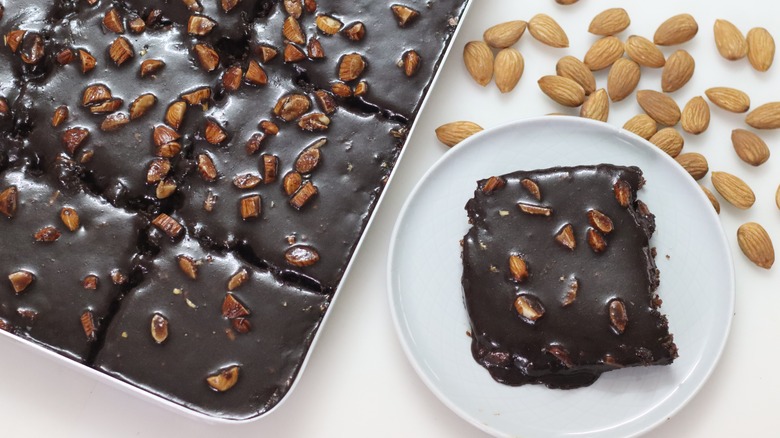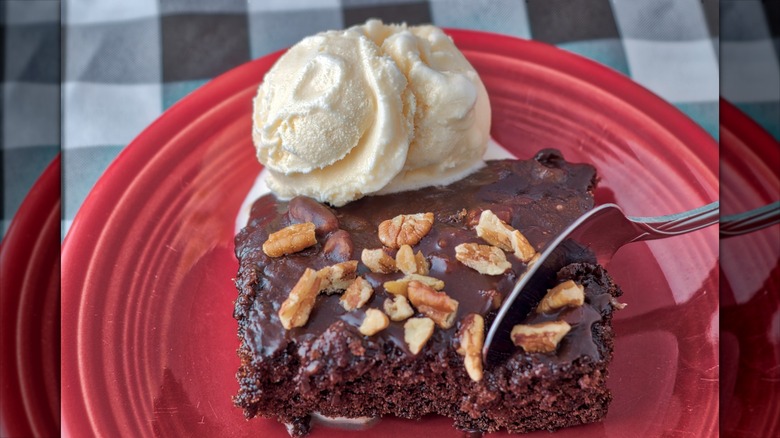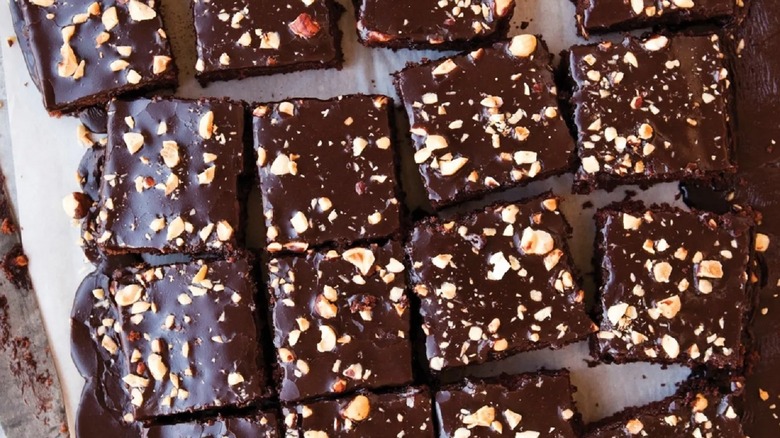What Makes Texas-Style Sheet Cake Different From Normal?
Sheet cakes are a sweet but humble addition to the dessert spread. Though they may not present as much visual grandeur as a layer cake or as much convenience as a cupcake, the sheet cake serves a crowd with little fuss but plenty of flavor. One of the most beloved incarnations of the sheet cake is the Texas sheet cake, but it looks a bit different from the rest.
Traditionally, when we think of sheet cakes, we picture a cake packed into a trusty 9x13 dish. But for a Texas sheet cake, like everything else in the Lone Star state, the dimensions are much bigger. The classic Texas sheet cake is often made with a jelly roll pan, a pan that measures 10x15 inches, or an even longer 12x18-inch sheet pan. The long, shallow pans allow for a short baking time and result in a thin, but still decadent cake. Then a rich chocolate frosting is applied to the still-warm cake, melting into the surface with a glossy finish. The final touch is a scattering of nuts, be it walnuts, almonds, or pecans (the orthodox choice). The result is a dessert that looks more like a nutty glazed brownie rather than a chocolate cake. So when did this sprawling chocolate cake first set itself apart from other standard sheet cakes?
A chocolate and nut-filled classic
The history of the Texas sheet cake is a bit murky. While it most likely came from the American South, it can't be pinned down to any one state. The rise of chocolate cakes and other cocoa-rich baked goods experienced an explosion in the early 1900s when chocolate became an affordable purchase for home cooks. Not long after, recipes for brownies and the brownie-like sheet cake began to emerge in community cookbooks.
In 1936, a recipe published in the "Galveston Daily News" featured a chocolate sheet cake baked in a jelly roll pan, but frosted with cooked vanilla icing. Not until the 1967 printing of the Alabaman "Huntsville Heritage Cookbook," did a cake that closely resembled our modern Texas sheet cakes pop up. Titled Mrs. Elkins' Sheath Cake, this thin cake was made with buttermilk and cocoa powder while the frosting was a mix of chocolate and chopped pecans. At the time, "sheath" was interchangeable with the word sheet, both referring to a shallow, long pan. Other chocolate sheet cakes with chocolate nut frosting and buttermilk consistently showed up, but these were baked in the classic 9x13 baking pan.
Even if all the ingredients were identical, the texture of the Texas sheet cake would still end up differently due to how quickly it would bake in the shallow pan. Plus, the cake is famed for its sweetness, so thinner servings make for a more palatable experience.
Is it truly Texan?
Why did the Lone Star state become attached to the cake in question? One suggestion is that the name is more a reference to the larger-than-life size of the cake, which calls to mind the Texas truism that bigger is always better. Others claim it bears enough resemblance to another Texan classic, the German chocolate cake, that it can be assumed it was first made there. German chocolate cake first popped up in Dallas in 1957 and featured the sweet combo of nuts, chocolate, and a buttermilk-lightened batter, all hallmarks of the Texas sheet cake. Rumors have also circulated that Lady Bird Johnson, one of Texas' most famous First Ladies, was the first to popularize Texas sheet cake to mainstream America, but that's been fairly debunked.
Whatever the reason, the Texas sheet cake name made its debut in the 1980s, showing up in cooking tomes like the "Austin Heritage Cookbook" and "Lone Star Legacy: A Texas Cookbook." Of course, some people don't even call it Texas sheet cake. Sometimes called Texas funeral cake, the dessert's generous portion size and delicate sweetness made it a natural addition to the bounty of food often served after the funeral. As one might expect, the less morbid title has won out in popularity, but it's all the same chocolate and pecan-covered cake.



